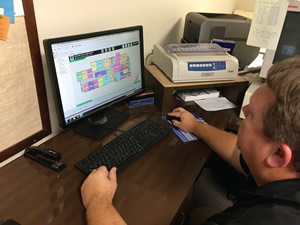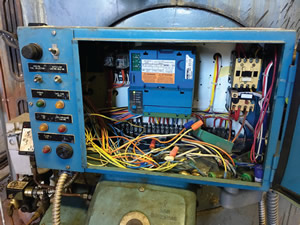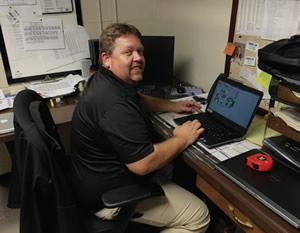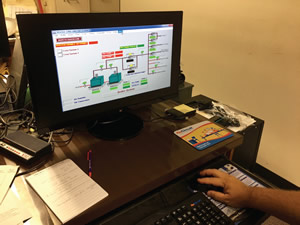Facilities (Learning Spaces)
Control Freaks

PHOTO BY ANDREW LAROWE
A well-designed energy savings program offers an additional benefit to facilities operations in the form of detecting abnormal issues with mechanical systems.
Imagine a school with perfect building systems. The HVAC and plumbing equipment would provide the correct level of comfort for everyone exactly when needed while maintaining a healthy and safe environment. It would continuously prevent pipes from freezing in the winter or allowing sensitive equipment to overheat in the summer. All equipment would be out of sight and run quietly in order to provide an optimal learning environment. All of this would be accomplished at the lowest possible cost and require very little maintenance. Unfortunately, for most school districts this is an elusive dream. With all the complexities associated with mechanical equipment in school buildings, most problems can be traced back to the controls we have in place for turning equipment on and off. School districts have learned that employing mechanical controls technicians and energy managers in their facilities operation is essential for maintaining the learning environment, protecting buildings, and reducing operational costs.
The thermostat was actually developed by a teacher who was frustrated over not being able to control the temperature in his classroom. In 1883, Warren Johnson set up his bi-metal sensing device to ring a bell in the boiler room when temperatures were falling to signal the custodian to shovel more coal into the boiler. Although there have been many developments with thermostats and pneumatic control systems over the years, everything changed in the ‘70s with the introduction of central air conditioning and computer technology in school buildings. With an interest in optimizing comfort and safety for the learning environment during the day and energy efficiency at night, schools quickly invested in automated control systems for mechanical equipment along with other building systems.

PHOTO BY ANDREW LAROWE
Hot stuff. With all the complexities associated with mechanical equipment in school buildings, most problems can be traced back to the controls we have in place for turning equipment on and off. When equipment issues are identified and corrected early on, the district can save major replacement expenses, reduce downtime, and substantially lower utility expenses.
It would be difficult to imagine using a computer for more than 10 years. Changes in technology have occurred so rapidly, outdated desktop equipment is typically rendered useless within four to five years. Unfortunately, the massive investments in Building Automation Systems (BAS) made by school districts over the past 30 years has quite often fallen behind the technology curve. Walk into many maintenance areas where technicians routinely pull up HVAC controls on their computers to enter schedules or troubleshoot problems, and you may hear the familiar sound of a dialup “handshake.” Although connecting to the internet by dial-up does not mean the district’s BAS system is not working, it is a clear signal the equipment is outdated. Facility managers tend to postpone replacing control systems until major equipment renovations are scheduled for each school. The problem is that the life cycles of the technology based controls and the mechanical equipment they are connected to are dramatically different. The frequency of occupant complaints and equipment downtime increases as the controls age out. Technicians find ways to temporarily solve problems by overriding controls, sometime allowing equipment to run continuously. This may satisfy the principals and the teachers for the time being; however, the cost of operation begins to soar.
Most school districts have, at one point or another, implemented energy conservation programs with the goal of reducing monthly costs for electricity, heating fuel, and water/sewer charges. Maintenance departments know they can rely on school staff to call for assistance when building systems are not working properly. Energy managers routinely visit schools during unoccupied periods at night, on weekends, and holidays. They report on how the building has been closed in relation to lights and instructional equipment being turned off, doors and windows closed, blinds turned down, etc. They also verify that HVAC equipment is operating according to established guidelines. Maintenance technicians who work with automated controls know very well that what they see on their computer screen does not always match actual conditions on site. Boilers, chillers, pumps, air handlers may be running when the computer indicates they are off. The problem may be related to a bad sensor, or programming errors, or simply an overlooked schedule. In any case, the energy manager is able to document the circumstances and hopefully have the issue addressed. Otherwise, equipment is left to run needlessly resulting in higher utility bills.

PHOTO BY ANDREW LAROWE
Keyed access. Jason Miller, energy manager at Davidson County Schools, in North Carolina, monitors a facility’s heating system from his desk. School districts have learned that employing mechanical controls technicians and energy managers in their facilities operation is essential for maintaining the learning environment, protecting buildings, and reducing overall operational costs. But, maintenance technicians who work with automated controls know very well that what they see on their computer screen does not always match actual conditions on site.
An essential element of all programs of this type involves a database system to collect valuable information from utility bills. By entering data from utility invoices into an energy monitoring and tracking software, energy managers are able to analyze energy usage as well as cost for each facility. By looking at cost per square foot, comparing schools within the district or comparing current use and cost to previous time periods, the energy manager can focus on specific circumstances that may need to be addressed by the school staff or the maintenance department.
Energy conservation programs typically extend to water/sewer utilities in school facilities. Watching the monthly bills a little closer may reveal costly problems for school districts. Water leaks may go unnoticed for months and in some cases years in the event school staff or maintenance cannot see evidence of the leak. Water may be finding a path to a storm drain or a sewer connection. Over time, the monthly invoice for water/sewer services, (including the leak) establishes a new norm and escapes notice by accounting. In many districts, the facilities department never sees the water bill, and without a comparative basis for normal usage, responsible staff members would probably not realize abnormal water usage. Many public utilities are willing to provide a credit adjustment to the water and/or sewer account of clients who have experienced an abnormal situation involving the loss of metered water.
Another important consideration related to controls for water systems relates to irrigation for school athletic facilities. There are recognizable issues regarding the frequency and amount of watering particularly in relation to rainfall. Upon review of monthly water/sewer invoices, energy managers often notice public school irrigation systems receiving sewer charges because the line is not submetered. A typical high school may incur as much as $10,000 to $15,000 a year in sewer charges for watering the grass. While there is an upfront cost for setting a separate meter and establishing a “water only” account, the payback period is typically less than a year.

PHOTO BY ANDREW LAROWE
Schools buildings must provide comfortable, safe spaces for children and staff during the day and effectively reduce the use of electricity, fuel, water, and sewer when the building is empty. To the extent possible, we can rely on building automation systems to optimize equipment operation. We can also depend on building occupants to report problems with equipment during the school day. A successful program must also pay close attention to the detailed information contained in monthly utility invoices and routinely perform site inspection in all buildings when they are unoccupied. One of the most effective ways this may be accomplished is by employing one or more energy managers assigned to work closely with maintenance. When equipment issues are identified and corrected early on, the district can save major replacement expenses, reduce downtime, and substantially lower utility expenses.
This article originally appeared in the School Planning & Management March 2019 issue of Spaces4Learning.